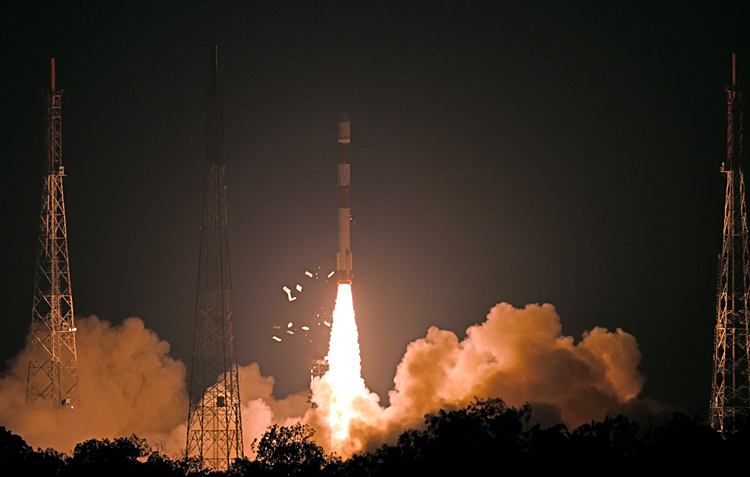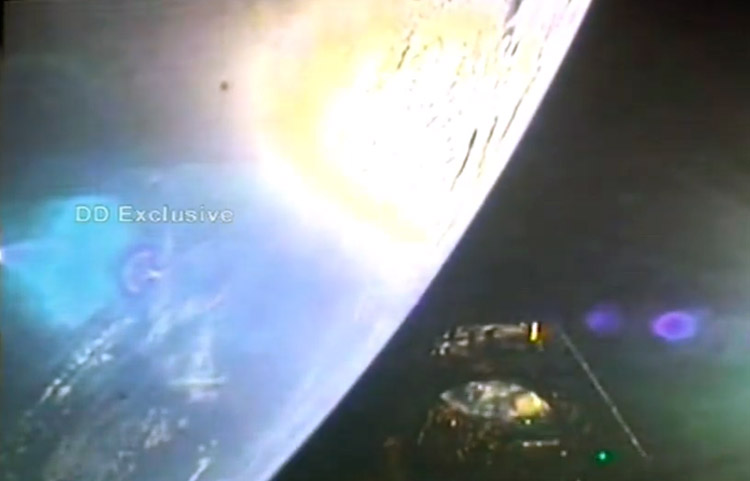INDIAN ARMED FORCES CHIEFS ON
OUR RELENTLESS AND FOCUSED PUBLISHING EFFORTS

SP Guide Publications puts forth a well compiled articulation of issues, pursuits and accomplishments of the Indian Army, over the years

I am confident that SP Guide Publications would continue to inform, inspire and influence.

My compliments to SP Guide Publications for informative and credible reportage on contemporary aerospace issues over the past six decades.
PSLV-C46, carrying RISAT-2B successfully launched by ISRO on Wednesday
Following two successful PSLV launches earlier this year, ISRO conducted yet another successful launch with PSLV-C46 carrying the earth observation satellite, RISAT-2B which is also expected to be used for military surveillance.

ISRO adds yet another feather to its hat in a series of successful missions this year, with the launch of PSLV-C46 carrying RISAT-2B on May 22, 2019 from Satish Dhawan Space Centre (SDSC) SHAR, Sriharikota. The Wednesday morning launch of the PSLV (Polar Satellite Launch Vehicle) marked the third launch in 2019, the 72nd launch vehicle mission from SDSC SHAR, Sriharikota and the 36th launch from the first launch pad. The previous two missions conducted earlier this year were; the PSLV-C44, which placed the Microsat-R and the Kalamsat-V2 satellites successfully in designated orbits on January 24 and the PSLV-C45/EMISAT mission, which successfully injected the EMISAT along with 29 international satellites into their orbits on April 1.
Intended to provide services in the field of agriculture, forestry and disaster management, RISAT-2B will replace the RISAT-2 which was launched successfully in 2009. With a mission life of five years, RISAT-2B is equipped with synthetic aperture radar that can take pictures of the earth during the day and night, and also under cloudy conditions.
ISRO Chairman Dr. K. Sivan congratulated the launch vehicle and satellite teams involved in the mission. "With this launch, PSLV lofts 50 tonnes to space by launching 354 satellites, including national, student and foreign satellites."

The earth observation satellite, RISAT-2B (Radar Imaging Satellite-2B) that weighs 615kg, lifted off the first launch pad at 5.30 am (IST) on Wednesday after the conclusion of the 25-hour countdown which began on Tuesday. About 15 minutes and 25 seconds after the lift-off, RISAT-2B was injected into an orbit of 556 km. Following a perfect launch and completion of all the four stages of the rocket, the payload was discharged into the intended orbit. PSLV-C46 was PSLV's 14th flight in its core-alone configuration without using the solid strap-on motors. The PSLV-core alone rocket, also the lightest among ISRO's launch vehicles, carried RISAT-2B in the shortest span of time that any Indian satellite has in the past, setting a record for the Indian Space Research Organisation (ISRO).
This launch also marks the expansion of ISRO's radar imaging satellite fleet in space.
After separation, solar arrays of RISAT-2B were deployed automatically and ISRO Telemetry Tracking and Command Network (ISTRAC) at Bengaluru assumed control of the satellite. In the coming days, the satellite will be brought to its final operational configuration, ISRO stated in its statement.
Dr. K Sivan also commended the efforts of the team involved in the realization of the piggyback payload carried onboard this mission namely, Vikram processor and low-cost MEMS-based Inertial Navigation System (INS) developed by Semi-Conductor Laboratory (SCL), Chandigarh and ISRO Inertial Systems Unit, Thiruvananthapuram respectively. He also quoted "RISAT-2B is an advanced Earth Observation satellite with the advanced technology of 3.6m radial rib antenna"
ISRO is now gearing up for the launch of Chandrayaan-2 onboard GSLV MkIII during the window of July 9, to July 16, 2019, with an expected Moon landing on September 6, 2019.
Intended to provide services in the field of agriculture, forestry and disaster management, RISAT-2B will replace the RISAT-2 which was launched successfully in 2009. With a mission life of five years, RISAT-2B is equipped with synthetic aperture radar that can take pictures of the earth during day and night, and also under cloudy conditions. The satellite is also expected to be used for military surveillance. The RISAT-2 was actively used by India to monitor activities in camps across the border to prevent infiltration bids, especially by terrorists. This launch also marks the expansion of ISRO's radar imaging satellite fleet in space. RISAT-1, a microwave remote sensing satellite was successfully launched by ISRO on April 26, 2012 from Sriharikota. The RISAT series holds the capability to observe weather conditions on Earth using radar imagery irrespective of the day- or nighttime, or weather conditions on the ground.
For a second consecutive time, ISRO made provisions for the general public to view the launch from a newly-built viewing gallery at the SDSC and as many as 5000 visitors witnessed the launch live from the Viewer's Gallery, which is open to the public.
ISRO is now gearing up for the launch of Chandrayaan-2 onboard GSLV MkIII during the window of July 9, to July 16, 2019, with an expected Moon landing on September 6, 2019. This promises to be the most challenging and the most anticipated mission taken up by ISRO.





